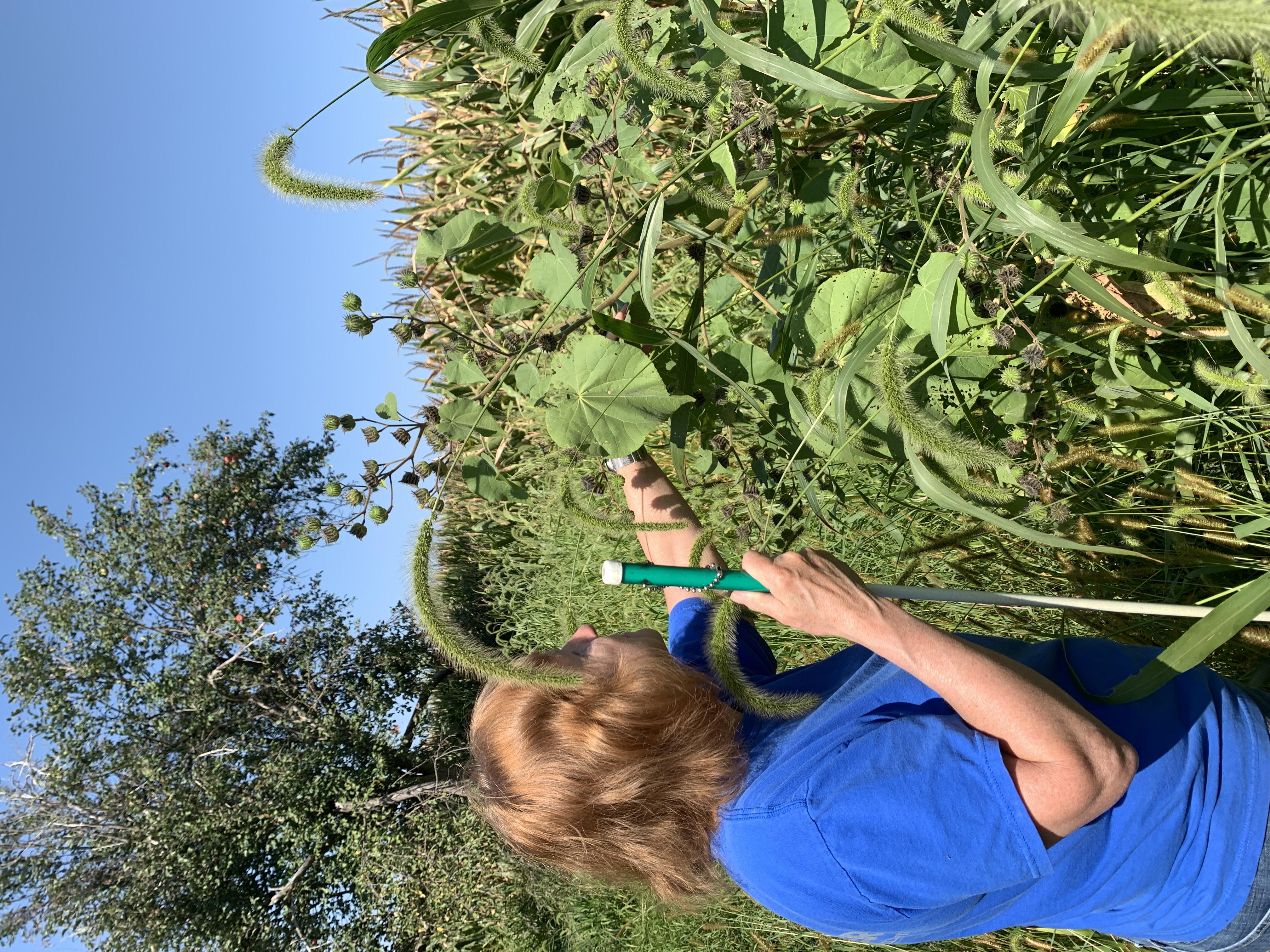It’s late summer now and the world is turning tan. Grasses are tired. Crops are drying, and three species of foxtails are waving their bottlebrush heads and dropping their seeds.
The smallest are the green foxtails (Setaria viridis), also known as green bristle grass, bottle grass, pigeon grass and wild millet. They stand about two feet tall on rigid stems with three or four long thin leaves alternating up the stem. The seed head is an upright, thin brush called a panicle, about two inches long. It started out green but turns tan and bends at the tip as it matures. Green foxtail originated in Europe and, like other foxtails and many other weeds, was imported into the Americas accidently in grain shipments.
The medium-sized one is the yellow foxtail ((Setaria pumila). It’s a little taller, and its brush is thicker and longer than the green foxtail. The brush stands erect and its bristles turn golden yellow in late summer. The yellow foxtail is native to Eurasia.
The giant foxtail is the biggest, growing up to six feet tall. It’s seed head is a cylindrical panicle at the tip of the rigid upright stem. It’s about seven inches long and about an inch thick. It nods, or bends over, like a fox’s tail and turns tan in the fall. The giant foxtail is native to China and east Asia.
All of the foxtails belong to the grass family. They are annual plants, germinating in spring when the soil temperature reaches 65 degrees. They flower in early summer, with inconspicuous green florets, and set seed from August through October.
Their brush-like seed heads are soft to the touch, but can cause serious injury to horses and cattle. Flowers and seeds develop on little spikelets. Each spikelet contains one to two florets which will turn into seeds. And each spikelet also has from one to five or more bristles called awns surrounding it. These awns are what gives the seed head its fuzzy, brush-like appearance. The awns carry tiny upward-pointing fish-hook-like barbs. When horses or cattle eat the foxtail seed heads, they can get those barbs stuck in their gums or tongue. The barbs don’t come out the way they went in, so they work their way farther into the tissue, causing major problems such as ulcers, abscesses, lesions and infections in the animal’s mouth. Yellow foxtail is the worst offender here. Below each of the tightly packed flower spikelets in the seed head are five or more of these fine, wiry barbed bristles. Because foxtails thrive in disturbed soils in pastures, fields, roadsides, and similar places, they are hard to control. Foxtails produce an average of 900 seeds per plant, and the seeds can lie dormant for several years under the right conditions.
Whereas foxtail is considered a weed around owl Acres, it has been cultivated as a grain for thousands of years. Originating in China, it spread across southeast Asia into India where it is still being cultivated as foxtail millet, a variant of our green foxtail. As a grass, it produces grain that can be threshed out of its seed heads and used in place of wheat or rice for food. Millet foxtail, (Setaria italica), has been cultivated in Asia from Siberia to India, and made its way into Europe over three thousand years ago. As a gluten-free grain, foxtail millet has attracted the attention of health food enthusiasts and people dealing with celiac disease.
The foxtails on Owl Acres aren’t destined to be grain for the table, though. Their seeds are scattering, hoping to colonize disturbed soil. Meanwhile, their heads nod in the late summer breezes and add texture to the landscape.
Photo by Author. Alt text: Karen stands on a riotous green hillside, surrounded by all three varieties of foxtails found on Owl Acres. Panicles of giant foxtail nod over her head, while green and yellow foxtails carpet the ground at her feet. Cornfield in the background, and an astonishingly productive Jonathan apple tree stands at the top of the hill. Karen is actually inspecting a velvetleaf, aka buttonweed, a broadleaf weed common in fencerows.

4 comments
I want to see the picture that you say is in this Heartland Safari, but don’t find any link to the picture(s). What am I doing wrong?
If you’re reading the email that announces the post, near the top is “Heartland Safari” in a small font. That’s a link to the site. The title of the post, e.g. “Milkweed” is also a link. There aren’t any pictures in the email itself, only online. We added the alt text for email readers because of the information it contains.